Keyang Wang
Learning states enhanced knowledge tracing: Simulating the diversity in real-world learning process
Dec 27, 2024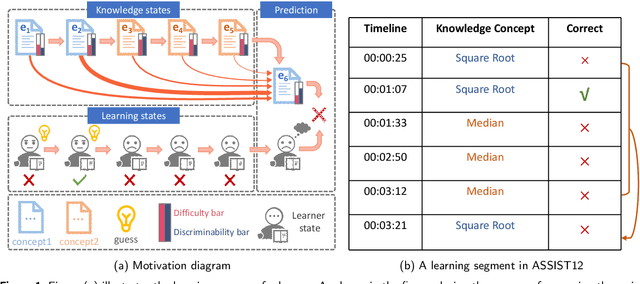
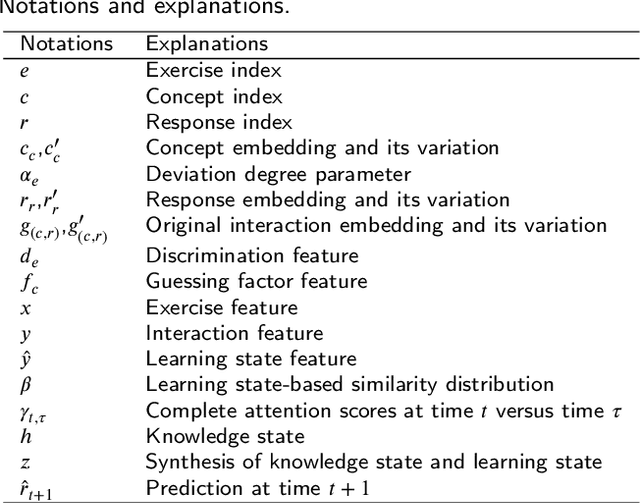


Abstract:The Knowledge Tracing (KT) task focuses on predicting a learner's future performance based on the historical interactions. The knowledge state plays a key role in learning process. However, considering that the knowledge state is influenced by various learning factors in the interaction process, such as the exercises similarities, responses reliability and the learner's learning state. Previous models still face two major limitations. First, due to the exercises differences caused by various complex reasons and the unreliability of responses caused by guessing behavior, it is hard to locate the historical interaction which is most relevant to the current answered exercise. Second, the learning state is also a key factor to influence the knowledge state, which is always ignored by previous methods. To address these issues, we propose a new method named Learning State Enhanced Knowledge Tracing (LSKT). Firstly, to simulate the potential differences in interactions, inspired by Item Response Theory~(IRT) paradigm, we designed three different embedding methods ranging from coarse-grained to fine-grained views and conduct comparative analysis on them. Secondly, we design a learning state extraction module to capture the changing learning state during the learning process of the learner. In turn, with the help of the extracted learning state, a more detailed knowledge state could be captured. Experimental results on four real-world datasets show that our LSKT method outperforms the current state-of-the-art methods.
Dual-State Personalized Knowledge Tracing with Emotional Incorporation
May 27, 2024



Abstract:Knowledge tracing has been widely used in online learning systems to guide the students' future learning. However, most existing KT models primarily focus on extracting abundant information from the question sets and explore the relationships between them, but ignore the personalized student behavioral information in the learning process. This will limit the model's ability to accurately capture the personalized knowledge states of students and reasonably predict their performances. To alleviate this limitation, we explicitly models the personalized learning process by incorporating the emotions, a representative personalized behavior in the learning process, into KT framework. Specifically, we present a novel Dual-State Personalized Knowledge Tracing with Emotional Incorporation model to achieve this goal: Firstly, we incorporate emotional information into the modeling process of knowledge state, resulting in the Knowledge State Boosting Module. Secondly, we design an Emotional State Tracing Module to monitor students' personalized emotional states, and propose an emotion prediction method based on personalized emotional states. Finally, we apply the predicted emotions to enhance students' response prediction. Furthermore, to extend the generalization capability of our model across different datasets, we design a transferred version of DEKT, named Transfer Learning-based Self-loop model (T-DEKT). Extensive experiments show our method achieves the state-of-the-art performance.
Personalized Forgetting Mechanism with Concept-Driven Knowledge Tracing
Apr 18, 2024



Abstract:Knowledge Tracing (KT) aims to trace changes in students' knowledge states throughout their entire learning process by analyzing their historical learning data and predicting their future learning performance. Existing forgetting curve theory based knowledge tracing models only consider the general forgetting caused by time intervals, ignoring the individualization of students and the causal relationship of the forgetting process. To address these problems, we propose a Concept-driven Personalized Forgetting knowledge tracing model (CPF) which integrates hierarchical relationships between knowledge concepts and incorporates students' personalized cognitive abilities. First, we integrate the students' personalized capabilities into both the learning and forgetting processes to explicitly distinguish students' individual learning gains and forgetting rates according to their cognitive abilities. Second, we take into account the hierarchical relationships between knowledge points and design a precursor-successor knowledge concept matrix to simulate the causal relationship in the forgetting process, while also integrating the potential impact of forgetting prior knowledge points on subsequent ones. The proposed personalized forgetting mechanism can not only be applied to the learning of specifc knowledge concepts but also the life-long learning process. Extensive experimental results on three public datasets show that our CPF outperforms current forgetting curve theory based methods in predicting student performance, demonstrating CPF can better simulate changes in students' knowledge status through the personalized forgetting mechanism.
Reconcile Prediction Consistency for Balanced Object Detection
Aug 27, 2021



Abstract:Classification and regression are two pillars of object detectors. In most CNN-based detectors, these two pillars are optimized independently. Without direct interactions between them, the classification loss and the regression loss can not be optimized synchronously toward the optimal direction in the training phase. This clearly leads to lots of inconsistent predictions with high classification score but low localization accuracy or low classification score but high localization accuracy in the inference phase, especially for the objects of irregular shape and occlusion, which severely hurts the detection performance of existing detectors after NMS. To reconcile prediction consistency for balanced object detection, we propose a Harmonic loss to harmonize the optimization of classification branch and localization branch. The Harmonic loss enables these two branches to supervise and promote each other during training, thereby producing consistent predictions with high co-occurrence of top classification and localization in the inference phase. Furthermore, in order to prevent the localization loss from being dominated by outliers during training phase, a Harmonic IoU loss is proposed to harmonize the weight of the localization loss of different IoU-level samples. Comprehensive experiments on benchmarks PASCAL VOC and MS COCO demonstrate the generality and effectiveness of our model for facilitating existing object detectors to state-of-the-art accuracy.
Layer-wise Customized Weak Segmentation Block and AIoU Loss for Accurate Object Detection
Aug 25, 2021
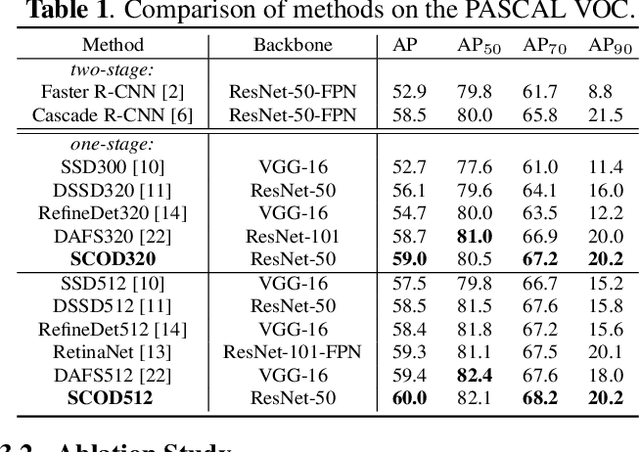
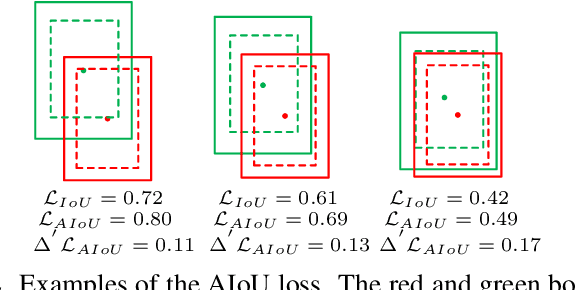
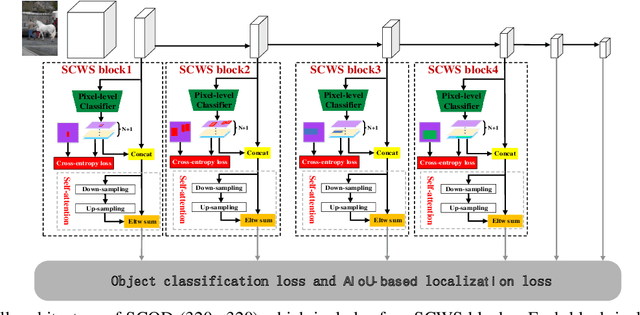
Abstract:The anchor-based detectors handle the problem of scale variation by building the feature pyramid and directly setting different scales of anchors on each cell in different layers. However, it is difficult for box-wise anchors to guide the adaptive learning of scale-specific features in each layer because there is no one-to-one correspondence between box-wise anchors and pixel-level features. In order to alleviate the problem, in this paper, we propose a scale-customized weak segmentation (SCWS) block at the pixel level for scale customized object feature learning in each layer. By integrating the SCWS blocks into the single-shot detector, a scale-aware object detector (SCOD) is constructed to detect objects of different sizes naturally and accurately. Furthermore, the standard location loss neglects the fact that the hard and easy samples may be seriously imbalanced. A forthcoming problem is that it is unable to get more accurate bounding boxes due to the imbalance. To address this problem, an adaptive IoU (AIoU) loss via a simple yet effective squeeze operation is specified in our SCOD. Extensive experiments on PASCAL VOC and MS COCO demonstrate the superiority of our SCOD.
Single-Shot Two-Pronged Detector with Rectified IoU Loss
Aug 08, 2020



Abstract:In the CNN based object detectors, feature pyramids are widely exploited to alleviate the problem of scale variation across object instances. These object detectors, which strengthen features via a top-down pathway and lateral connections, are mainly to enrich the semantic information of low-level features, but ignore the enhancement of high-level features. This can lead to an imbalance between different levels of features, in particular a serious lack of detailed information in the high-level features, which makes it difficult to get accurate bounding boxes. In this paper, we introduce a novel two-pronged transductive idea to explore the relationship among different layers in both backward and forward directions, which can enrich the semantic information of low-level features and detailed information of high-level features at the same time. Under the guidance of the two-pronged idea, we propose a Two-Pronged Network (TPNet) to achieve bidirectional transfer between high-level features and low-level features, which is useful for accurately detecting object at different scales. Furthermore, due to the distribution imbalance between the hard and easy samples in single-stage detectors, the gradient of localization loss is always dominated by the hard examples that have poor localization accuracy. This will enable the model to be biased toward the hard samples. So in our TPNet, an adaptive IoU based localization loss, named Rectified IoU (RIoU) loss, is proposed to rectify the gradients of each kind of samples. The Rectified IoU loss increases the gradients of examples with high IoU while suppressing the gradients of examples with low IoU, which can improve the overall localization accuracy of model. Extensive experiments demonstrate the superiority of our TPNet and RIoU loss.
 Add to Chrome
Add to Chrome Add to Firefox
Add to Firefox Add to Edge
Add to Edge